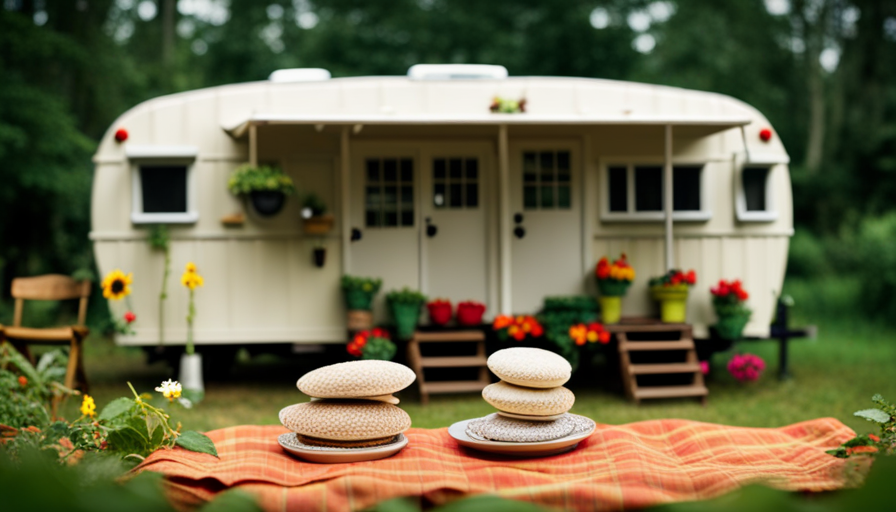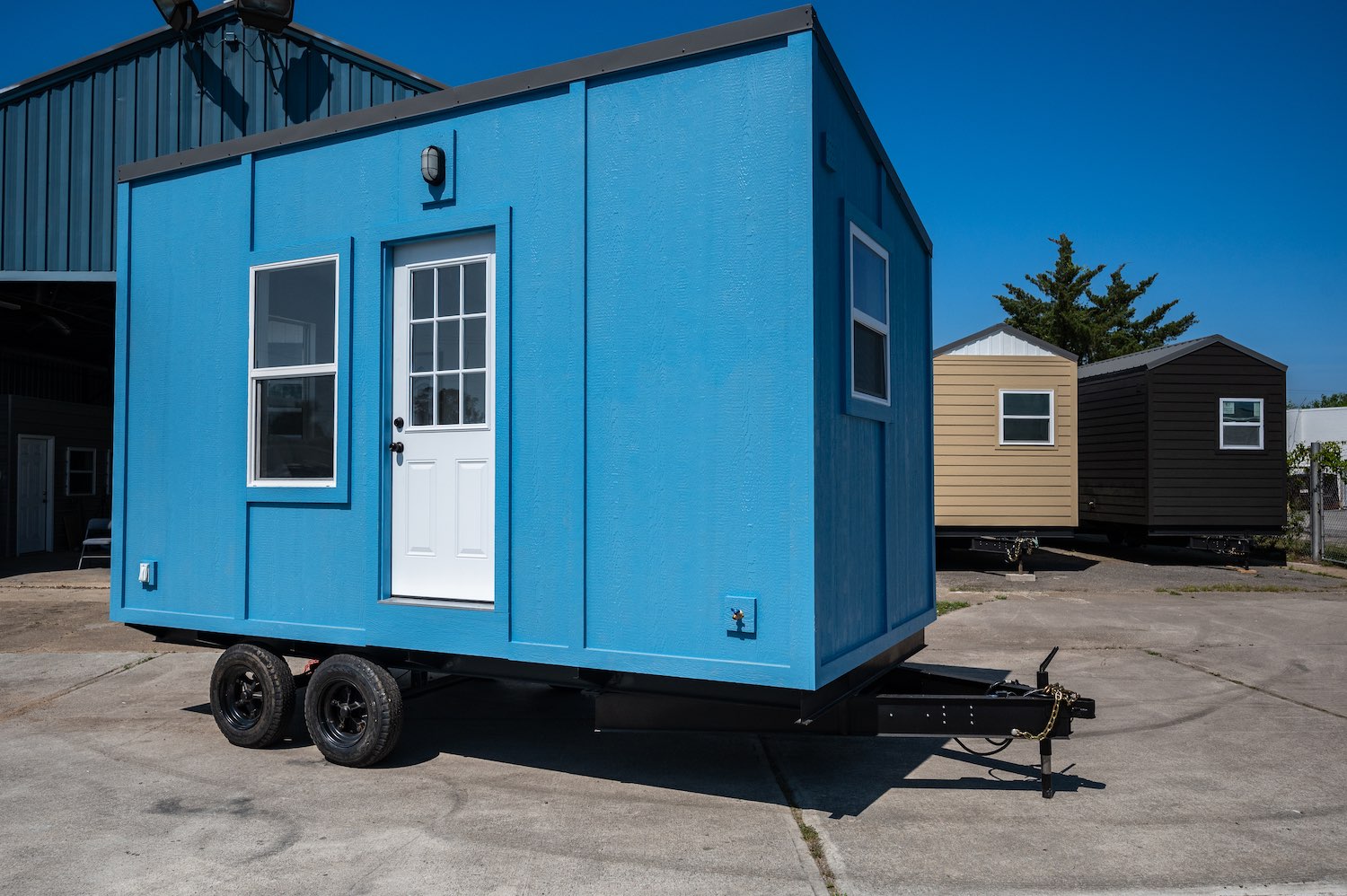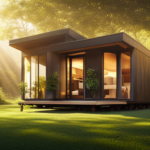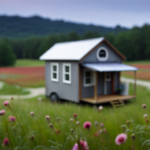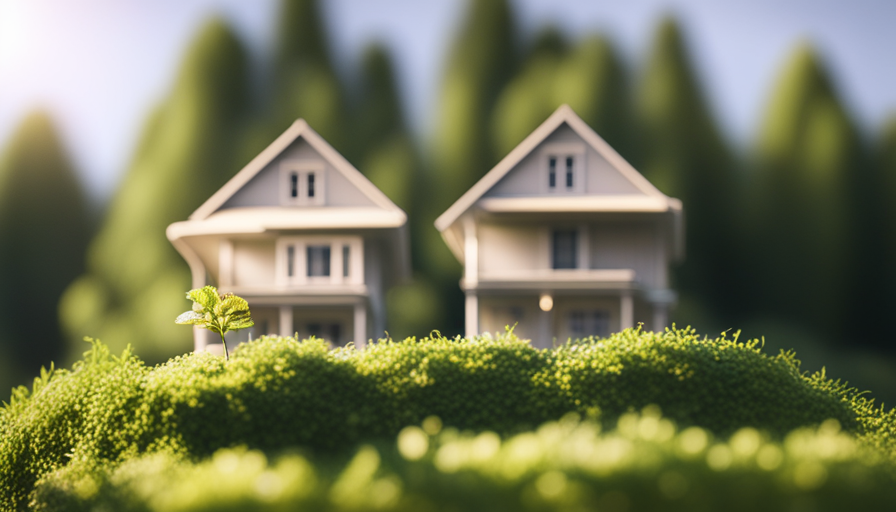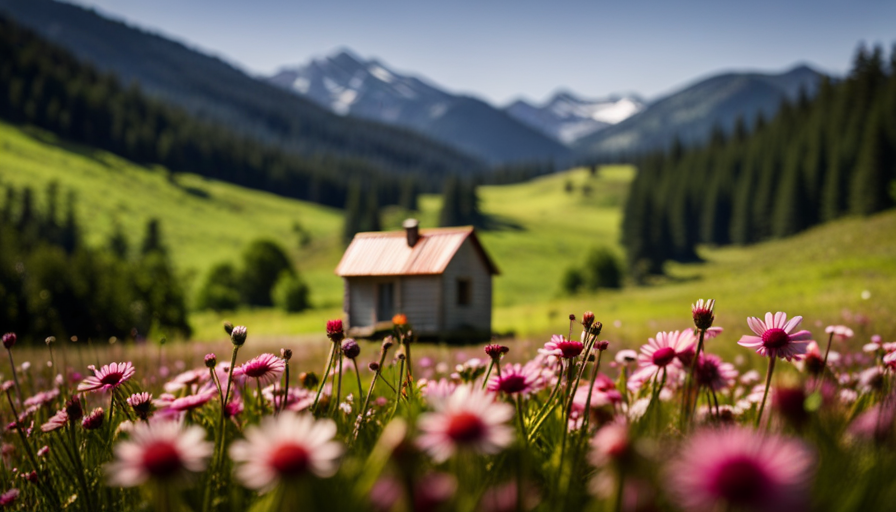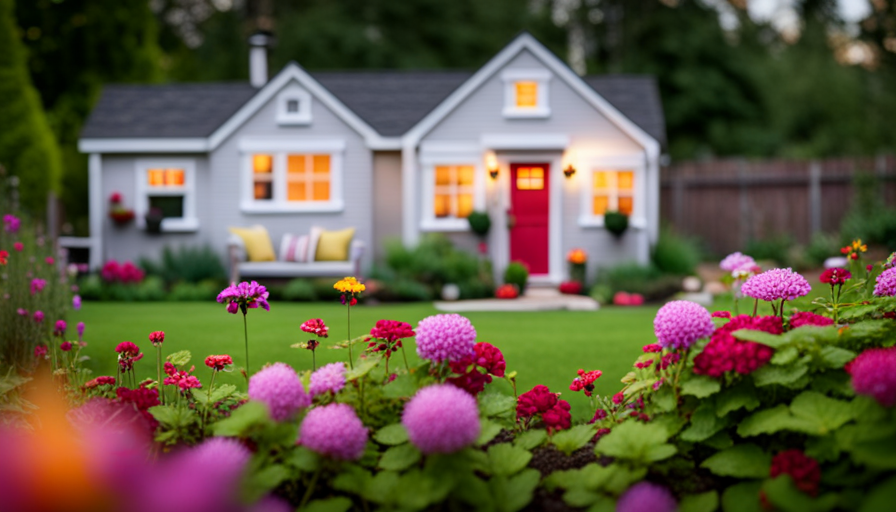Looking for the ideal home? They say that “good things come in small packages.” And what better way to discover this than with a tiny house kit? These small and customizable homes have become incredibly popular, providing a distinctive and cost-effective living option for those who want to simplify or adopt a minimalist lifestyle.
But just how much does a tiny house kit cost? Well, as the saying goes, ‘you get what you pay for.’ The price of a tiny house kit can vary depending on several factors, including the size, materials used, and additional features.
In this article, we will explore the different types of tiny house kits available, factors that influence pricing, average cost ranges, and ways to save money. So, whether you’re dreaming of a cozy cabin in the woods or a modern urban oasis, join me as we dive into the world of tiny house kits and discover the possibilities that await.
Key Takeaways
- Tiny house kits offer an affordable living solution for downsizing or embracing a minimalist lifestyle.
- The average cost range for tiny house kits is $10,000 to $50,000, depending on size, materials, and additional features.
- Financing options include in-house financing, personal loans, and home equity loans.
- Careful planning, budgeting, and thorough research are important for finding the right kit and creating a functional tiny home.
Types of Tiny House Kits Available
If you’re curious about the different types of tiny house kits available, you’ll be amazed at the variety and options that are out there. From DIY kits to turnkey solutions, there is something to suit every budget and skill level.
One of the first things you might be wondering is, how much does a tiny house kit cost on average? Well, the price can vary depending on several factors, such as the size of the kit, the materials used, and the level of customization. On average, you can expect to pay anywhere from $10,000 to $50,000 for a tiny house kit. However, it’s important to note that this is just an estimate and prices can go higher or lower based on your specific needs and preferences.
When it comes to financing options for tiny house kits, the good news is that there are several options available. Some companies offer in-house financing, allowing you to pay for the kit in installments over a certain period of time. Additionally, there are also traditional financing options, such as personal loans or home equity loans, that can be used to finance your tiny house kit.
Now that you have an idea of the average cost and financing options available, let’s delve into the factors that influence pricing.
Factors That Influence Pricing
When it comes to pricing for tiny house kits, there are several factors that play a role in determining the cost.
One important factor is the size and square footage of the kit. Generally, the larger the kit, the more expensive it will be.
Additionally, the materials used in the construction of the kit can greatly impact the price. Higher quality materials will often result in a higher cost.
Lastly, the design and features of the kit can also influence the pricing. Kits with unique or custom designs, as well as additional features such as built-in furniture or upgraded appliances, may come with a higher price tag.
Size and Square Footage
Although small in stature, tiny house kits pack a punch with their clever use of space and cozy square footage. When considering the cost of a tiny house kit, one important factor to take into account is the size and square footage of the house. Generally, the larger the size of the tiny house, the higher the cost of the kit. This is because larger houses require more materials and labor to build. However, it’s important to note that the cost isn’t solely determined by size. It also depends on how efficiently the space is utilized. Some tiny house kits are designed with innovative storage solutions and multi-functional furniture, maximizing every inch of space. This can contribute to a higher price tag, but it also ensures that you’re getting the most out of your tiny home. Transitioning into the next section about materials used, it’s also worth considering the quality of materials in relation to cost.
Materials Used
The materials used in these kits create a sense of luxury and craftsmanship, making you feel like you’re living in a high-end dream home. The tiny house kits are constructed using high-quality, sustainable materials that not only contribute to the overall aesthetics but also have a low environmental impact.
Some of the common materials used include:nn1. Recycled wood siding: This not only adds a rustic charm to the exterior but also reduces the demand for new timber, minimizing deforestation.
-
Energy-efficient windows: These windows are designed to maximize natural light and ventilation while minimizing energy consumption, helping to reduce utility bills.
-
Eco-friendly insulation: The kits often utilize insulation made from recycled materials, providing efficient temperature control and reducing heat loss.
When considering the cost comparison, it’s important to factor in the long-term savings from reduced energy consumption and maintenance costs.
Moving on to the next section about ‘design and features’, the attention to detail in these kits is truly impressive.
Design and Features
Get ready to be blown away by the exquisite design and impressive features that’ll make you feel like you’re living in a luxurious mansion.
When it comes to tiny house kits, customization is key. These kits offer a wide range of design options, allowing you to personalize your space to suit your needs and style preferences. From sleek modern designs to rustic cabins, there’s a tiny house kit for every taste.
Not only do these kits provide a beautiful aesthetic, but they also incorporate innovative space-saving solutions. Clever storage compartments, foldable furniture, and multi-purpose rooms make the most of every inch of space. With these customizable designs and innovative features, you can create a tiny house that’s both functional and stylish.
Now, let’s move on to the next section and explore the average cost range of tiny house kits.
Average Cost Range of Tiny House Kits
Tiny house kits can range in cost, but you’ll be pleasantly surprised to find that they often fit within a reasonable budget. The average cost range for tiny house kits is typically between $10,000 and $40,000. However, factors such as size, design, materials, and additional features can affect pricing.
Larger kits with more intricate designs and high-quality materials will generally be at the higher end of the price range.
Despite the varying costs, tiny house living offers numerous benefits that make the investment worthwhile. These include reduced expenses on utilities, lower maintenance costs, and the ability to live a more sustainable lifestyle. Additionally, tiny houses can be customized to meet individual needs and preferences, allowing for a unique and personalized living space.
It’s important to keep in mind that while the kit itself may fall within a reasonable budget, there are additional costs to consider. These can include site preparation, foundation, utilities hookup, interior finishes, and appliances. These factors can significantly impact the overall cost of your tiny house project. Nonetheless, with careful planning and budgeting, you can create a beautiful and functional tiny home that fits your needs and lifestyle while staying within your desired budget.
Additional Costs to Consider
When considering the cost of a tiny house kit, it’s important to take into account the additional costs that may arise. These hidden costs and unexpected expenses can quickly add up and significantly impact your budget. While the average cost range of tiny house kits can give you a general idea, it’s crucial to consider the following factors that may incur additional expenses:
-
Shipping and Delivery: Depending on the size and weight of the kit, shipping costs can vary greatly. It’s essential to factor in these expenses to avoid any surprises.
-
Site Preparation: Before assembling your tiny house kit, you may need to prepare the site by clearing land, leveling the ground, or pouring a foundation. These costs can vary depending on the condition of the site.
-
Utilities and Hookups: Connecting your tiny house to utilities such as electricity, water, and sewage may require additional expenses, especially if your chosen location is not already equipped for these connections.
By considering these additional costs, you can better estimate the total investment required for your tiny house project. In the next section, we will explore ways to save money on tiny house kits, allowing you to make informed decisions while keeping your budget in mind.
Ways to Save Money on Tiny House Kits
When it comes to saving money on tiny house kits, there are a few key points to consider.
First, opting for a DIY construction can significantly cut costs as you won’t have to pay for labor.
Second, using recycled or salvaged materials can also help save money and give your tiny house a unique, eco-friendly touch.
Lastly, choosing simpler designs can reduce the overall cost of materials and construction.
These three strategies can help you save money while still achieving your dream of owning a tiny house.
DIY Construction
If you’re feeling handy, you can save a ton of money by constructing your own tiny house kit. DIY construction is a popular option for those looking to cut costs and add a personal touch to their tiny home.
Here are three key advantages of building your own tiny house kit:
-
Cost Comparison: Building your own tiny house kit can be significantly cheaper than purchasing a pre-built one. You have more control over the materials and can choose affordable options that fit your budget.
-
Customization: DIY construction allows you to customize every aspect of your tiny house. From the layout to the finishes, you can create a space that reflects your unique style and needs.
-
Learning Experience: Building your own tiny house kit is a rewarding learning experience. It offers an opportunity to gain new skills and knowledge in construction, design, and problem-solving.
By using recycled or salvaged materials, you can further reduce costs and create an eco-friendly tiny home.
Using Recycled or Salvaged Materials
Consider using recycled or salvaged materials to create a unique and environmentally friendly space for your DIY tiny home construction. Using reclaimed materials not only reduces waste and saves money, but it also adds character and charm to your tiny house.
There are many eco-friendly building options available, such as reclaimed wood for flooring, salvaged windows for natural light, and repurposed fixtures for a touch of nostalgia. These materials can be found at salvage yards, online marketplaces, or even through community recycling programs.
By incorporating recycled materials into your tiny house, you’re not only reducing your carbon footprint but also giving new life to items that would have otherwise been discarded. Transitioning into the subsequent section about opting for simpler designs, it’s important to consider how these reclaimed materials can enhance the overall aesthetic of your tiny home.
Opting for Simpler Designs
For a more laid-back and effortless vibe, go for simpler designs when creating your DIY tiny home. Simpler designs not only provide a minimalist living experience but also make the construction process easier and more affordable.
By opting for clean lines, open spaces, and fewer embellishments, you can create a cozy and functional living space without the need for excessive materials or complex construction techniques. Simplicity in design also allows for more flexibility in customization, enabling you to personalize your tiny house according to your specific needs and preferences.
Whether you choose a modern or rustic aesthetic, simpler designs can help you achieve a harmonious and clutter-free living environment. So, if you’re looking to simplify your life and reduce your ecological footprint, consider embracing the beauty of simpler designs when building your own tiny home.
When it comes to financing options for tiny house kits, there are several avenues to explore that can make your dream of owning a tiny home a reality.
Financing Options for Tiny House Kits
Looking to finance your tiny house kit? You’ll be glad to know that there are various options available to help you make your dream home a reality.
Tiny house kit financing can be obtained through a variety of alternative funding options. One popular choice is personal loans, which can be used to cover the cost of purchasing the kit and any additional expenses. These loans typically have lower interest rates than credit cards, making them a more affordable option.
Another option is crowdfunding, where you can create a campaign to raise funds for your tiny house kit. This allows you to tap into the support of friends, family, and even strangers who believe in your dream.
Additionally, some tiny house kit manufacturers offer financing plans, allowing you to pay for your kit over time. These plans often come with flexible payment options and competitive interest rates. However, it’s important to carefully consider the terms and conditions of any financing option before committing to it.
In the subsequent section, we will discuss the pros and cons of living in a tiny house, helping you make an informed decision about whether it’s the right choice for you.
Pros and Cons of Living in a Tiny House
Imagine the freedom of living in a cozy space that encourages simplicity and minimalism. That’s the allure of living in a tiny house. While it may not be for everyone, there are certainly pros and cons to consider when deciding if this lifestyle is right for you.
One of the main advantages of living in a tiny house is the sense of community that comes with it. Tiny house communities are popping up all over the country, providing a supportive network of like-minded individuals who value sustainable living and a smaller carbon footprint. Additionally, living in a tiny house can offer financial freedom, as the cost of living is significantly lower than in a traditional home.
However, downsizing to a tiny house does come with its challenges. Limited space means that you have to carefully consider what you bring into your home and be intentional about your belongings. This can be a difficult adjustment for those used to having more space to store their possessions. Additionally, living in a tiny house may require a change in mindset, as you have to be comfortable with a minimalist lifestyle and be willing to let go of unnecessary clutter.
Living in a tiny house has its advantages and challenges. It offers a sense of community and financial freedom, but downsizing and adjusting to a minimalist lifestyle can be difficult. When considering a tiny house, it’s important to weigh these factors and choose a kit that suits your needs and preferences.
Tips for Choosing the Right Tiny House Kit
When it comes to choosing the right tiny house kit, there are a few key points that I’ve found helpful in my own research.
First, it’s important to assess your needs and lifestyle to determine what features and specifications are essential for your tiny home.
Next, researching different manufacturers will allow you to compare the quality, price, and options available.
Lastly, reading reviews and testimonials from other tiny house owners can provide valuable insight into the overall experience and satisfaction with a particular kit.
Assessing Your Needs and Lifestyle
To truly embrace the minimalist lifestyle, you must assess your needs and lifestyle, much like a sculptor chiseling away at excess stone to reveal the masterpiece within. When considering a tiny house kit, it’s important to assess your needs and determine what features and amenities are essential for your daily life.
Some key factors to consider include the number of occupants, the layout and design of the house, and any specific functionality requirements. Additionally, budget considerations play a significant role in determining the right tiny house kit for you.
Assessing your financial capabilities and setting a budget will help narrow down your options and ensure you choose a kit that’s within your means. By carefully assessing your needs and budget, you can make an informed decision when researching different manufacturers and their offerings.
Researching Different Manufacturers
Explore various manufacturers to discover the perfect fit for your minimalist lifestyle, as each one offers unique options and designs that will captivate your imagination and meet your specific needs. Conducting thorough research is essential in finding the right tiny house kit for you. Start by considering your research methods and exploring different manufacturers. One effective way to compare options is by creating a table that outlines the key features of each manufacturer’s kits. This will allow you to easily compare prices, sizes, materials, and any additional features that may be important to you. Additionally, take the time to read customer reviews and testimonials to gauge their satisfaction with the kits and the manufacturer’s customer service. This will provide valuable insights into the overall quality and reliability of the products. Transitioning into the next section, reading reviews and testimonials will further assist you in making an informed decision.
Reading Reviews and Testimonials
Check out what other customers have to say about their experiences with different manufacturers and their satisfaction with the kits and customer service. Reading testimonials can provide valuable insights into the quality and reliability of the tiny house kits available. It allows you to gauge the level of customer satisfaction and make a more informed decision.
Testimonials can highlight the benefits of tiny house living, such as affordability, sustainability, and the freedom to live a simpler lifestyle. They can also shed light on any potential issues or challenges that customers may have encountered during the building process.
By reading testimonials, you can gain a better understanding of which manufacturers provide high-quality kits and excellent customer support. This knowledge will help you make an informed decision when selecting a popular tiny house kit manufacturer to proceed with.
Popular Tiny House Kit Manufacturers
One of the top contenders in the tiny house kit market is Tumbleweed, offering stylish and customizable options for aspiring minimalist homeowners. Tumbleweed has become one of the most popular tiny house kit manufacturers due to its high-quality materials and attention to detail.
Their kits range in size from around 100 to 400 square feet, providing homeowners with the perfect amount of space to live comfortably.
In terms of cost, tiny house kits from Tumbleweed can vary depending on the size and customization options chosen. On average, a Tumbleweed tiny house kit can cost anywhere from $20,000 to $80,000. While this may seem expensive compared to traditional homes, it’s important to consider that tiny houses are significantly smaller and more energy-efficient, resulting in lower maintenance and utility costs in the long run.
Real-life examples and success stories of people who have built and lived in Tumbleweed tiny houses are a testament to the quality and functionality of these kits. From young couples looking to downsize to retirees seeking a simpler life, Tumbleweed has helped individuals and families achieve their dreams of living in a tiny house.
These stories demonstrate the endless possibilities and satisfaction that come with choosing a Tumbleweed tiny house kit.
Real-Life Examples and Success Stories
Now that we’ve explored the popular tiny house kit manufacturers, let’s dive into some real-life examples and success stories.
One inspiring success story is that of Sarah and Mark, a couple from Oregon who decided to downsize and simplify their lives. They purchased a tiny house kit and customized it to fit their needs. Not only were they able to save money on housing costs, but they also found a sense of freedom and fulfillment in their minimalist lifestyle.
Another example is Jason, a single father from California. He built a tiny house kit on his own, using it as a way to bond with his teenage son. Not only did they create a beautiful home together, but they also learned valuable skills and strengthened their relationship in the process.
These real-life examples demonstrate that tiny house living isn’t just a trend; it can truly change lives. With determination, creativity, and the right tiny house kit, anyone can achieve their dream of living in a compact and sustainable home.
Frequently Asked Questions
Are permits required to build a tiny house using a kit?
Permits are typically required to build a tiny house, regardless of whether it’s a kit or not. Zoning laws vary, so it’s important to check with your local authorities before starting construction.
Can a tiny house kit be customized to fit specific needs and preferences?
Yes, a tiny house kit can be customized to fit specific needs and preferences. There are various customization options available, such as choosing the layout, finishes, and additional features. However, customization may add to the overall cost considerations.
How long does it typically take to assemble a tiny house kit?
On average, it takes about 2-4 weeks to assemble a tiny house kit. However, the assembly time can vary depending on factors such as the complexity of the design and any common challenges that may arise during the process.
Are tiny house kits suitable for year-round living in different climates?
Tiny house kits offer year-round living in different climates. They are cost-effective and provide the advantage of customization. With proper insulation and heating/cooling systems, tiny houses can be comfortable in any weather.
Are there any restrictions or regulations on where a tiny house kit can be parked or placed?
Parking regulations and zoning restrictions vary by location, so it’s important to research and comply with local laws before parking or placing a tiny house kit. These regulations dictate where and how tiny houses can be parked or placed.
Conclusion
In conclusion, after researching the various types of tiny house kits available and considering the factors that influence pricing, I’ve come to realize that the cost of a tiny house kit can vary greatly.
On average, the cost ranges from $10,000 to $40,000, but it’s important to also consider additional costs such as land, utilities, and permits. However, there are ways to save money on tiny house kits, such as building it yourself or purchasing a used kit.
Living in a tiny house has its pros and cons, but it can be a fulfilling and sustainable lifestyle for those who embrace it. When choosing the right tiny house kit, it’s crucial to consider your needs and preferences, as well as the reputation of the manufacturer. Real-life examples and success stories can provide inspiration and guidance throughout your tiny house journey.
Hi, I’m Emma. I’m the Editor in Chief of Tiny House 43, a blog all about tiny houses. While tree houses are often associated with childhood, they can be the perfect adult retreat. They offer a cozy space to relax and unwind, surrounded by nature. And since they’re typically built on stilts or raised platforms, they offer stunning views that traditional homes simply can’t match. If you’re looking for a unique and romantic getaway, a tree house tiny house might just be the perfect option.

